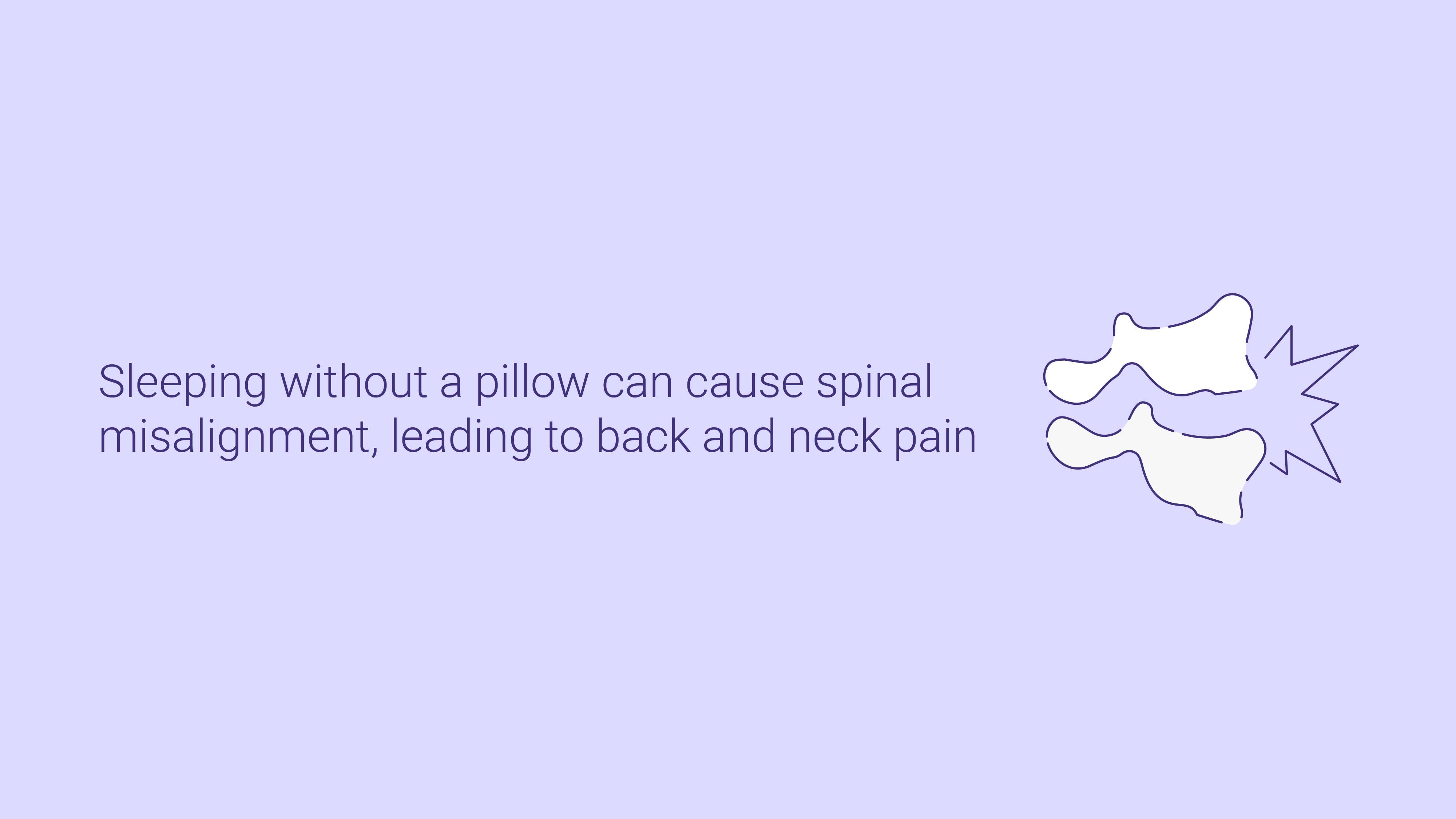
All The Pros and Cons of Sleeping Without a Pillow

- Consider your sleep position when choosing a pillow, ensuring the neck remains aligned with the spine.
- Sleeping without a pillow may reduce wrinkles and alleviate back and neck pain for stomach sleepers.
- However, without proper support, sleeping without a pillow can lead to discomfort, poor sleep quality, and spinal misalignment.
Pillows can make your bed feel more comfortable and inviting. However, pillows do more than create a cozy sleep space. The right pillow will keep the neck aligned with the rest of your body, so your spine is in a safe, neutral position. When the spine is aligned, the muscles in your neck, shoulders, and back can completely relax and recover during sleep.
So, while you might be tempted to try sleeping without a pillow, it is not a good idea for most sleepers. However, there are cases when going to bed without a pillow can reduce pain. Throughout this article, we cover the pros and cons of sleeping without a pillow. Plus, we explain how to choose the right pillow for your sleep position and how to safely sleep without a pillow if you want to give it a try.
Pros of Sleeping Without a Pillow
Sleeping without a pillow is not right for everyone. However, for stomach sleepers, resting your head directly on the mattress may have some benefits.
May Alleviate Back and Neck Pain for Stomach Sleepers
According to sleep experts, stomach sleeping can often lead to chronic neck and back pain because this position forces the spine to bow unnaturally. When the torso sinks into the bed, the hips and shoulders lift, causing the natural curvature of the spine to become exaggerated. With a medium to high loft pillow beneath the head, this curve can become even more pronounced.
Resting with the spine in this position causes the muscles to tighten and clench during sleep and often leaves sleepers feeling stiff and sore in the morning. Therefore, it is best to avoid stomach sleeping whenever possible.
However, if you find it difficult to avoid this sleep position or if you need to rest on your stomach for a medical reason, sleeping without a pillow can help. With the head flat on the mattress, the neck is more likely to remain aligned with the spine, reducing muscle tension and helping stomach sleepers wake with less pain.
While sleeping without a pillow can help alleviate back and neck pain for stomach sleepers, we do not recommend it to back and side sleepers. When resting on your back or side, the head tends to fall below the shoulders, causing tension to build up in the neck. These sleepers need a medium to high loft pillow to keep the head propped up and in line with the spine.
Reduce Wrinkles
Recent studies have shown that facial skin becomes compressed during sleep, contributing to wrinkles and other aging signs. Therefore, some people have turned to sleeping with a skinny pillow or no pillow at all to reduce facial compression and slow the formation of wrinkles.
However, due to the potential risk associated with pillow-less sleeping for back and side sleepers, it is best to find other ways to reduce the appearance of wrinkles. For example, using a high-quality sunscreen and daily moisturizer and eating a healthy diet full of fruits and vegetables can help prevent wrinkles.
Cons of Sleeping Without a Pillow
Although sleeping without a pillow may be beneficial for side sleepers, there are still potential risks of resting directly on the mattress.
Spinal Misalignment
While sleeping without a pillow can lessen the spine’s curve when resting on your stomach, this position will not create a completely natural position. Since body weight tends to pull the torso down when stomach sleeping, the spine will always remain slightly curved, putting pressure on the neck and back muscles.
When resting on your back or side, the head needs to stay lifted and aligned with your neck and hips. Sleeping without a pillow will cause the neck and back muscles to remain stiff and tight throughout the night.
Discomfort and Poor Sleep Quality
Sleeping without a pillow can cause spinal misalignment, leading to back and neck pain. Plus, it can be difficult to relax and fall asleep quickly when your head is left unsupported. While stomach sleepers may be able to get comfortable without a pillow, side, back, and combination sleepers will have a much harder time fully relaxing without a comfortable pillow.

A soft, conforming pillow, such as latex and memory foam pillows, will cradle the neck and maintain a neutral spine so you can melt into your mattress and experience deeper, more restful sleep.
How to Choose the Right Pillow
Your preferred sleeping position can help determine the pillow height, or “loft,” right for you.
Side Sleepers
In most cases, medium to high loft pillows are best for side sleepers because they keep the head lifted and in line with the neck, spine, and hips. A low loft pillow will cause the head to droop and put pressure on the neck muscles. Ultra-soft pillows that collapse immediately can also cause neck pain for side sleepers.
Latex and memory foam pillows work well for side sleepers because they respond to pressure immediately, so you stay supported even as you change positions.
Back Sleepers
The best pillows for back sleepers have a medium loft. If the pillow is too high, it can force the head forward, bending the neck and causing muscle tension. A medium loft, contouring pillow will cradle the head and neck, ensuring it remains aligned with the spine to alleviate pressure.
Stomach Sleepers
As we mentioned above, it is best to avoid stomach sleeping whenever possible. However, stomach sleepers should try to lessen the curve of the spine as much as possible. This can be done by sleeping without a pillow or with a thin pillow.
Stomach sleepers can also place a thin pillow under the pelvis to alleviate tension in the lower back.
Tips for Sleeping Without a Pillow
If you are a stomach sleeper and want to try sleeping without a pillow, the following tips can help you find deep sleep and reduce muscle tension.
Gradually Reduce Support
To make the transition easier, it is best to lower your pillow’s support or height over time. You can do this by using a towel as a pillow and unfold it a little each night until your head is resting flat on your bed.
Support Your Body with Pillows
Stomach sleepings who prefer not to use a pillow should place a thin pillow beneath the pelvis to gently lift the hips and lessen the pressure on the spine.
Although it is not recommended for side and back sleepers to rest without a pillow beneath the head, if you do so, be sure to use other pillows to help support the rest of your body. For example, back sleepers can benefit from placing a pillow beneath their knees to alleviate lower back pain. Side sleepers can place a pillow between their knees to reduce hip pain.
Sleep on a Supportive Mattress
Mattresses are not one-size-fits-all—what works for a lightweight side sleeper will not support a heavier back sleeper. Your sleep position and body weight can help you determine the right mattress for you. Below, we provide a quick overview of the mattress firmness suitable for each sleep position and body type.
Sleeping Positions:
- Side Sleepers: Soft to medium firmness to cradle and protect the joints from pressure points
- Back Sleepers: Medium to medium-firm mattress firmness to prevent excess sinking and spinal misalignment
- Stomach Sleepers: Extra-firm mattress to keep the hips lifted and aligned with the shoulders
- Combination Sleepers: Medium firmness for a balance of cushioning and support no matter which position they take
Body Types:
- Lightweight Individuals (less than 130 pounds): Soft to medium mattress firmness to reduce pressure points
- Heavier Individuals (230 pounds or more): Medium-firm to firm mattress to prevent over sinking and awkward sleep positions that lead to muscle tension
Frequently Asked Questions
What is the healthiest way to sleep?
In most cases, sleeping on the right side is the healthiest sleep position. Right side sleeping helps pull the heart to the center of the chest, reducing pressure on the heart and lung to prevent palpitations and shortness of breath.
However, pregnant women should rest on their left side because right-side sleeping can reduce blood flow to the fetus.
What is the best pillow for sleep apnea?
Those with sleep apnea should rest on a wedge pillow with a 35 to 45-degree angle. With the upper body elevated, the soft tissue at the back of the throat falls forward rather than backward, preventing airway obstruction. When breathing is easier, sleepers are less likely to experience symptoms of sleep apnea.
How long should a stiff neck last?
Acute neck pain is typically caused by straining the neck during work, sleep, or physical activity. In most cases, this pain lasts between one to two weeks. If neck pain lasts longer than three months, it is best to seek your doctor or physical therapist’s advice.
Why can’t I move my neck after waking up?
If you strain the muscles or ligaments in your neck during sleep, you may wake up with a stiff neck. In most cases, this pain goes away after a day or so. However, if you notice that you are frequently waking up with neck pain, you may be resting on an unsupportive pillow. To get a better night’s sleep, make sure that your pillow is not too high or too low. The goal is to keep the neck and head aligned with the shoulders, spine, and hips.
How often should you change your pillows?
You should replace your pillows every 1 to 2 years. Even high-quality pillows will eventually lose some of their loft and their ability to keep your head and neck supported. Also, if you start to notice neck or upper back pain, it may be time to replace your pillow.
Bottom Line
While some sleepers may find relief from neck and back pain by sleeping without a pillow, this is not the case for most sleepers. To maintain a neutral spine and wake up feeling refreshed, the head and neck should be supported.
However, when choosing the best pillow for you, be sure to keep your sleep position in mind. If you are a back sleeper, you may prefer a softer pillow with a medium loft. However, if you are a side sleeper, a firmer, medium to high loft pillow may be just what you need for better sleep.
